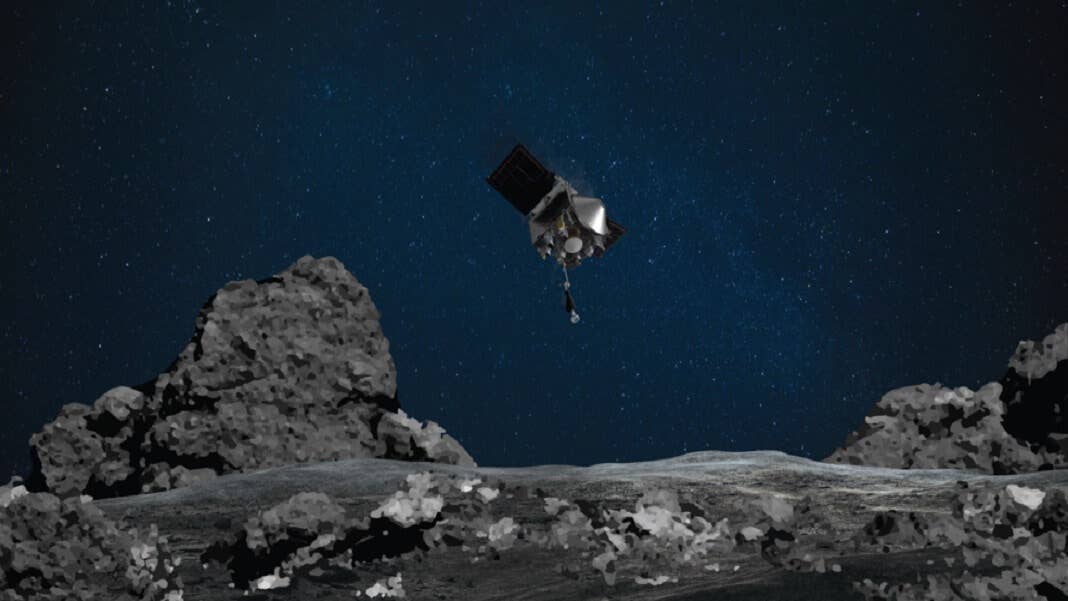NASA’s About to Try Grabbing a Chunk of Asteroid to Bring to Earth—and You Can Watch

Share
If you’ve seen the movie The Martian, you no doubt remember the rescue scene, in which (spoiler alert!) Matt Damon launches himself off Mars in a stripped-down rocket in hopes of his carefully-calculated trajectory taking him just close enough to his crew for them to pluck him from the void of outer space and bring him safely home to Earth. There’s a multitude of complex physics involved, and who knows how true-to-science the scene is, but getting the details right to successfully grab something in space certainly isn’t easy.
So it will be fascinating to watch NASA aim to do just that, as its OSIRIS-REx spacecraft attempts to pocket a fistful of rock and dust from an asteroid called Bennu then ferry it back to Earth—with the whole endeavor broadcast live on NASA’s website starting Tuesday, October 20 at 5pm Eastern time. Here are some details to know in advance.
The Asteroid
Bennu’s full name is 101955 Bennu, and it’s close enough to Earth to be classified as a near-Earth object, or NEO—that means it orbits within 1.3 AU of the sun. An AU is equivalent to the distance between Earth and the sun, which is about 93 million miles. The asteroid orbits the sun at an average distance of 105 million miles, which is just (“just” being a relative term here!) 12 million miles farther than Earth’s average orbital distance from the sun.
Every six years, Bennu comes closer to Earth, getting to within 0.002 AU. Scientists say this means there’s a high likelihood the asteroid could impact Earth sometime in the late 22nd century. Luckily, an international team is already on the case (plus, due to Bennu’s size and composition, it likely wouldn’t do any harm).
Bennu isn’t solid, but rather a loose clump of rock and dust whose density varies across its area (in fact, up to 40 percent of it might just be empty space!). Its shape is more similar to a spinning top than a basketball or other orb, and it’s not very big—about a third of a mile wide at its widest point. Since it’s small, it spins pretty fast, doing a full rotation on its axis in less than four and a half hours. That fast spinning also means it’s likely to eject material once in a while, with chunks or rock and other regolith dislodging and being flung into space.
The Spacecraft
OSIRIS-REx stands for Origins, Spectral Interpretation, Resource Identification, Security-Regolith Explorer. Yeah—that’s a lot. It’s the size of a large van (bigger than a minivan, smaller than a bus), and looks sort of like a box with wings and one long arm. It’s been orbiting Bennu for about two years (since 2018) after taking two years to get there (it was launched in 2016).
The spacecraft’s “arm” is called TAGSAM, which stands for Touch-And-Go Sample Acquisition Mechanism. It’s 11 feet long and has a round collection chamber attached to its end.
Be Part of the Future
Sign up to receive top stories about groundbreaking technologies and visionary thinkers from SingularityHub.


OSIRIS-REx doesn’t have any legs to land on, but that’s for a good reason: landing isn’t part of the plan. Which brings us to…
The Plan
As far as plans go, this one is pretty cool. The spacecraft will approach the asteroid, and its arm will reach out to tap the surface. A pressurized canister will shoot out some nitrogen gas to try to dislodge some dust and rock from Bennu, and the collection chamber on the spacecraft’s arm will open up to grab whatever it can; scientists are hoping to get at least 60 grams’ worth of material (that’s only 4 tablespoons! It’s less than the cup of yogurt you eat in the morning!).
And that’s not even the wildest detail; if the mission goes as planned and OSIRIS-REx scoops up those four tablespoons of precious cargo, scientists on Earth still won’t see them for almost three more years; the spacecraft is scheduled for a parachute landing in the Utah desert on September 24, 2023.
The NASA team working on this project thinks it’s likely they’ll find organic material in the sample collection, and it may even give them clues to the origins of life on Earth.
Does the mission have better odds of success than Matt Damon’s rescue in The Martian? Tune in on Tuesday to see for yourself.
Image Credit: NASA
Vanessa has been writing about science and technology for eight years and was senior editor at SingularityHub. She's interested in biotechnology and genetic engineering, the nitty-gritty of the renewable energy transition, the roles technology and science play in geopolitics and international development, and countless other topics.
Related Articles

Data Centers in Space: Will 2027 Really Be the Year AI Goes to Orbit?

Scientists Say We Need a Circular Space Economy to Avoid Trashing Orbit

New Images Reveal the Milky Way’s Stunning Galactic Plane in More Detail Than Ever Before
What we’re reading